|
Andre Citroen is credited
with bringing mass production to Europe during the First World War by
producing artillery shells and munitions in his massive government backed
purpose-built brand new factory at Quay Javel in Paris on a massive scale, and
coordinating it with supplies of munitions from others, and keeping up with the
ever-increasing demands for shells which to lob at Kelser Bill.
So by 1919, and the looming end of the war, Citroen he had a lovely
massive automated factory and nothing to make in it as shells in quantity
were no longer needed. This is when he turned relatively rapidly to
designing and introduction of his first car. (Full story at http://www.svvs.org/citroen3.shtml
)
The first car, the Citroen
10HP Model A, was delivered in July 1919. This he followed quite soon
after with a relatively similar beefed-up '10 HP Model B' in May 1921, and
simultaneously with a smaller '5HP Model C', which was also announced in
1921. The Model C was a two-seater for Ladies. All three cars had a
'family look', quite new for the time but useful in remembering the
Citroen 'shape'. |
In
the meantime, Paulin Ratier, a wood-working specialist who had moved to
Paris from Montmurat in 1904, had established himself as a
cabinetmaker in Paris Montrouge. It seems that his specialist knowledge of
wood and metal, and how they co-reacted with each other, enabled him to
diversify and specialise in the art of making of propellers for the infant
aviation industry. He had few competitors. So just as for Citroen
supplying shells to the French army, for Ratier the looming end of the war
was going to mean a disastrous turndown of business having supplied 12,000
propellers to the French Airforce. Propellers in quantity were no longer
needed. He too had to diversify.
It seems that in 1921 the Technical
Director of Helices Ratier, Paul Dreptin, had persuaded his boss that they
had a future in the automobile industry by putting a propeller at the
front of the car in the similar manner as they had been supplying propellers to Marcel Leyat who
was making propeller driven cars; having own coachbuilding
facilities, they even supplied the the bodies for Leyat. |
Marcel Leyat had established a company in Paris in 1919 where he began to
make the 'Helica',
"the plane without wings" which was steered via the rear wheels
and had a giant propeller at the front powered by a 1200cc two-cylinder
Scorpion engine which provided the propulsion. Suggested advantage of the
propeller system was
that there was no gearbox, no clutch, and no rear axle, all of which
reduce the weight and complexity, and significantly improve the fuel
economy. The vehicle weighed 250KG and reached the impressive speed of 171kph at
Montlhery. Occupants sat behind each
other and initially there was no weather protection. Apparently 600 orders were received
at the 1921 Paris Motor Show but only some 30 Helica vehicles were built
between 1919 and 1925. |
|
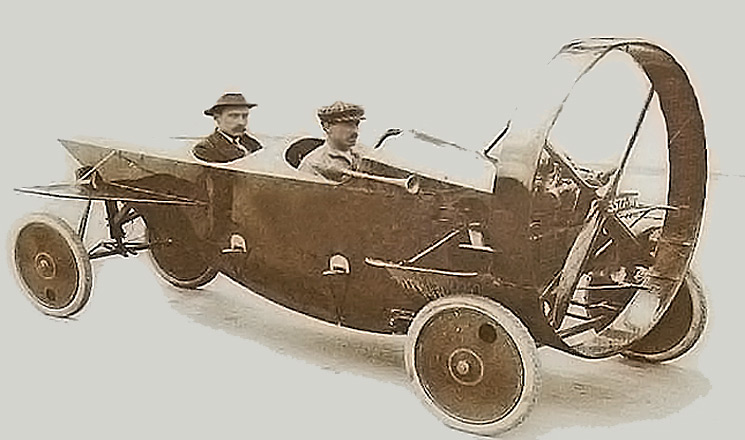
|
This embarked Ratier on making their own
"Voiture Ratier Helices" or "Automobile a Traction Aerienne"
using their own propellers.
Patent was obtained in 1923 for what was quite an impressive vehicle of
1,000kg capable of 130kph from a 3.2L Janvier-Sabin four-cylinder engine
of 70HP. It had a 3m wheelbase and 1.4m track with a streamlined body
which could hold three people. Initially two blade propeller, later four
blade. What was indeed unique about it was that it was possible to chose
means of propulsion; propeller, wheels, - or both. Nevertheless, unlike
Citroen with his cars, the propeller car did not catch on, the idea did
not fly, no sales, and
only the prototype was made. |
|
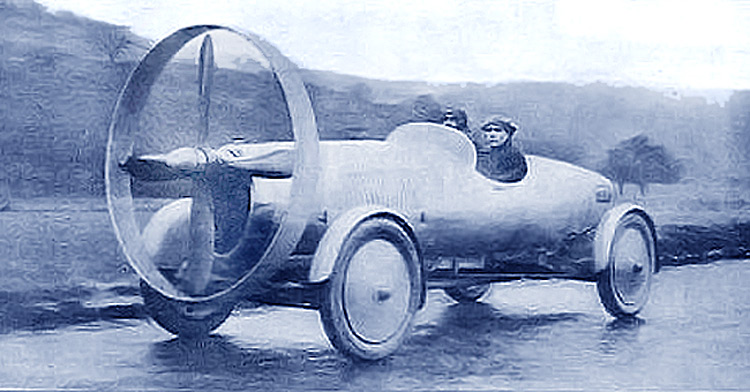
|
So Paul Dreptin hit on
another idea and persuaded his boss that they should be making,
…Citroens. They had the experience of the specialised woodworking and
metalworking skills necessary to have provided coach-built vehicles to their
clients, so set about manufacturing one of the most popular cars of the
time, the Model C Citroen two seater. They dispensed with the engine,
added pedals instead, reduced the size of the car to about quarter scale,
had large pneumatic tyres, had working electrics and in 1924 registered
the name "Citroenette".
The vehicle was extremely well built with a high-class finish which meant
that the price was about FF 1,000, at the time when the price of the full
seize model was FF 8,000.
The main problem with the vehicle was
that it was very expensive for what it was, a child's Pedal Car, and it
proved somewhat difficult to sell. So one of the company salesmen
suggested to the boss Ratier that perhaps they should visit Andre Citroen
and see if he would like a couple for his kids? A meeting was set up where
the Citroenette was demonstrated by a little lad pedaling furiously.
Andre Citroen apparently went quiet for a while, and then wrote out an
order for 3,000.
|
|
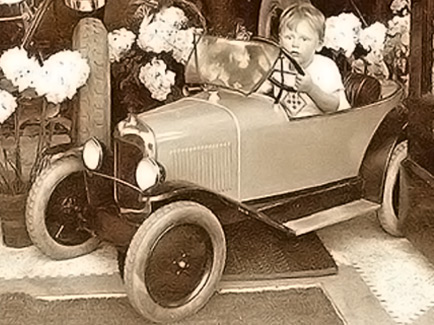
|
Very soon the Citroen company took over
all the marketing of all of the Citroenettes leaving Helices Ratier to
make the vehicle minus the tyres. Andre's friend Michellin had a given a
good price to equip all Citroens with Michellin tyres, so why not the
'Comfort Junior' for Citroenette.
The business took off in 1924 because
Andre Citroen could see the great advantage of having a Citroenette at
most of his Distributors' showrooms country-wide where not only did the
scale model look very much like the real thing at minimal cost, but all
kids in the neighbourhood would drag their parents to the showroom to be
able to sit the Citroennette going 'brum-brum'. Nothing quite like brand
loyalty, catch them when they are young, Citoenise ! |
|
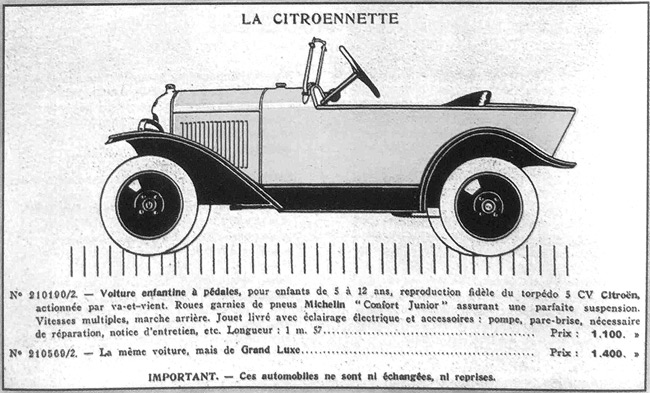
|
|

Photos thanks www.losson.com
|
Citroenette pedal cars became a business
in its own right and were marketed with the full weight of Citroen behind
them. Many thousands were made. Like their full size counterparts, the
Citroenettes were made in various, colours, yellow, red, blue and green,
and in various levels of trim; standard, standard luxe and extra Luxe.
Seven types pf vehicles were offered. The shape of the external parts kept
up with the changes on the real thing, like the shape and type of
mudguards, windscreens and bonnets. Battery provided power for the
lighting system, and shock absorbers provided a cushioned ride. Pedal
cranks provided motion via chain to the rear axle. Some very special
models were painted white with gold or silver fittings and sold to the
likes of famous department stores like Printepms and Bon Marche, to film
stars, rich and famous and royalty, and exported to the likes of the son
of Price Farouk of Egypt.
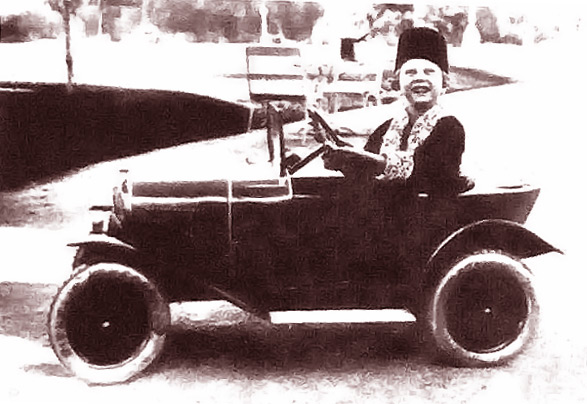
|
Having grabbed the attention of the
likely purchasing motoring audience, Citroenettes were then expanded to be
sold in various level of trim to Photographers' Studios where at the time
a real model was considerably more convincing than a normal hand painted
backdrop of a simile-car at the back of the studio. Village children also
did not go without because simplified versions of Citroenettes were made
to go on various types of fairground and static merry-go-rounds. |
|
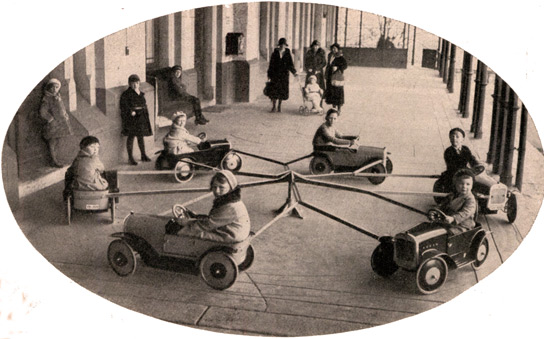
|
In 1926, despite the sales of the
full-size Citroen 5CV being very healthy, Andre Citroen decided to stop
manufacturing the two-seater because the costs of building the wood and
metal vehicles were reaching the same proportions as that of the much
bigger new all-steel B14 four seater saloon. With the discontinuation of
the torpedo shaped 5CV it soon became apparent that the manufacture of the
similar Citroenette could not continue, so in 1927 the production of the
Citroenette was also stopped at Helices Ratier. |
Paulin Ratier went on to
head many other ventures in the aero and auto field including the design
and manufacture of a conventional sports car with a 750cc engine launched
at that time in 1926. The car was available in three body styles including
a racing model and proved very successful in competition at places such as
Bol d'Or, Boulogne and Brooklands. More than 30 were made between
1926-29. |
|
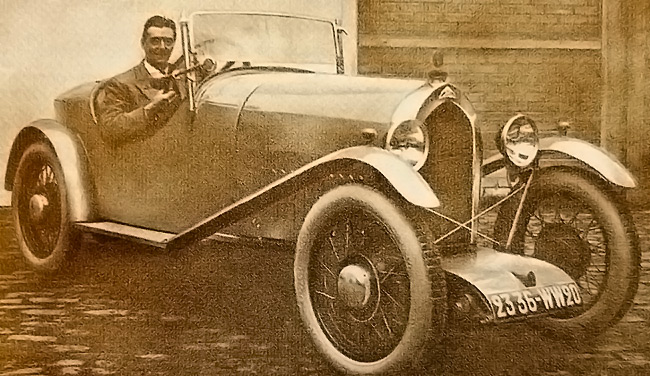
|
During
World War 2 the Ratier factory at Figeac
produced
bicycles and also later produced aircraft parts for the German Luftwaffe, but the
French Resistance raided the premises causing considerable damage. After
the war, as reparations, a new company CEMEC were given many BMW
motorcycle components enabling them to build and continue building
motorcycles of some similarity to BMW. Ratier took the company over and some
1,200 machines were manufactured, many as police motorcycles. General De Gaulle
only used Ratier Motorcycles as his Presidential Escort. The contract was
not renewed in 1962. |
|
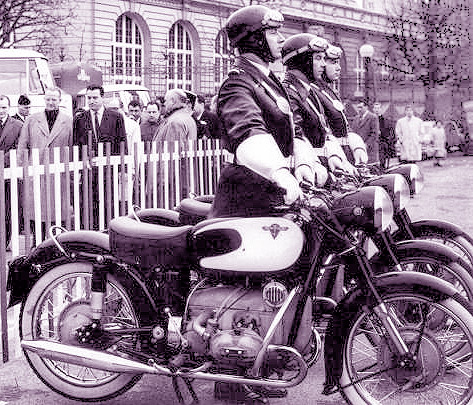
|
|
As a postscript to the Citroenette saga,
the original Paulin Ratier enterprise which started in 1904, and was later
named Ratier Figeac, ebbed and flowed with the world economy and ensuing
states of peace and wars, and including various subsequent mergers and
take-ove, is very much still in
existence today as The Ratier Figerac Company active in the global aerospace
industry including turboprop propellers and systems for the Airbus.
|
Go to Recent Venues
Page
PICTURE GALLERY INDEX
|